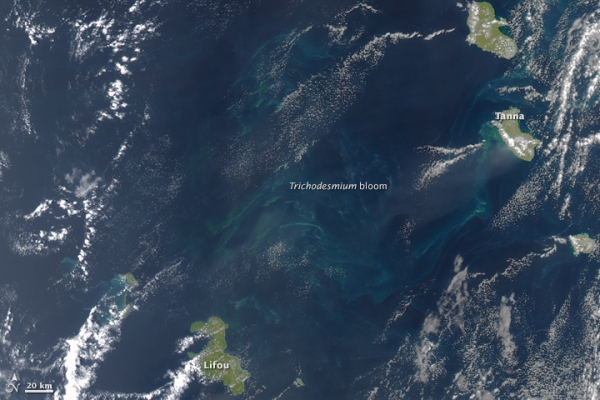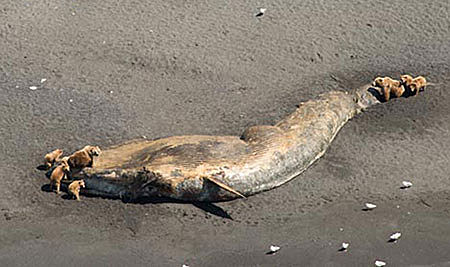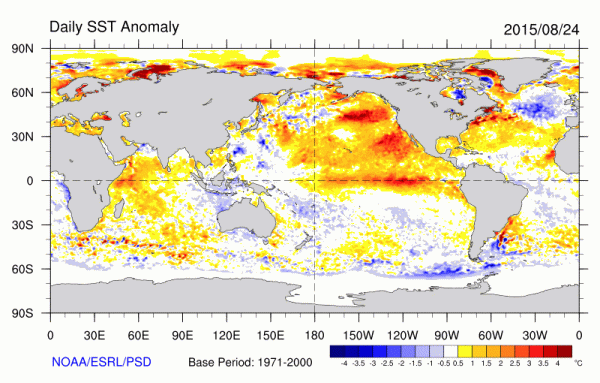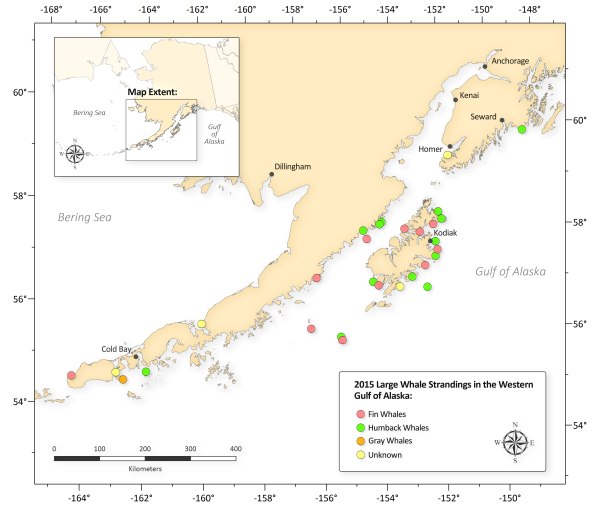Trichodesmium. It’s the bacteria that’s solely responsible for the fixation of nearly 50 percent of nitrogen in the world’s oceans. A very important role for this microscopic critter. For without nitrogen fixation — or the process by which environmental nitrogen is converted to forms usable by organisms — most of life on Earth would not exist.
Now, a new study produced by USC and the Massachusetts-based Woods Hole Oceanographic Institution (WHOI), has found that human carbon emissions are set to drive this essential organism haywire. Forcing evolutionary changes in which the bacteria is unable to regulate its growth. Thus generating population explosions and die-offs that will be very disruptive to the fragile web of life in the world’s oceans.
(A Trichodesmium bloom off New Caledonia. Image source: Earth Observatory.)
Trichodesmium — A Mostly Helpful Bacteria Essential to Ocean Life
Trichodesmium is a form of cyanobacteria. It resides in the near surface zone composing the top 200 meters of the water column. Possessing gas vacuoles, the bacteria is able to float and sink through the water column in order to access the nutrients it needs for growth — nitrogen, iron, and phosphorus. A widespread bacteria, it is often found in warm (20 to 34 C), nutrient-poor waters in the Red Sea, the Indian Ocean, the North and South Atlantic, the Caribbean, near Australia, and in the Northeastern Pacific.
Trichodesmium congregates in blooms which are generally a straw-like color. For centuries, this coloration has generated its common name — sea straw. However, in higher concentrations it can turn waters red. The Red Sea, for example, owes its name to this prolific little bacteria. Trichodesmium blooms generate a strata that support mutualistic communities of sea creatures including bacteria, diatoms, dinoflagellates, protozoa, and copepods. These small organisms, in turn, are fed on by a variety of fish — notably herring and sardines.
But Trichodesmium’s chief role in supporting ocean health is through making nitrogen in the air and water available to living organisms. It does this by turning environmental nitrogen into ammonia as part of its cellular metabolism. This ammonia can then be used for growth by a wide variety of creatures on up the food chain. Trichodesmium is an amazing producer of this biologically available nitrogen — perhaps generating as much as 50 percent of organic nitrogen in the world’s oceans (70 to 80 million metric tons) each year.
Human Fossil Fuel Burning is Projected to Drive Trichodesmium Haywire
But now a new study by USC and WHOI shows that atmospheric CO2 concentrations projected to be reached by the end of the 21st Century in the range of 750 ppm CO2 could force Trichodesmium’s nitrogen fixation rate into overdrive and lock it there indefinitely.
(Rate of nitrogen fixation in Trichodesmium at 380 ppm CO2 [black and red], at 750 ppm CO2 [pink, yellow and light blue], and when CO2 levels are returned to 380 ppm after five years of exposure to 750 ppm levels [dark blue]. Image source: Nature.)
The study subjected Trichodesmium to atmospheric CO2 concentrations (750 ppm) projected under a somewhat moderate rate of continued fossil fuel burning scenario by 2100 for five years. After this five year period of exposure, Trichodesmium nitrogen fixation rates nearly doubled (see above graphic). But, even worse, after the Trichodesmium bacteria were returned to the more normal ocean and atmospheric conditions under 380 ppm CO2, the rate of nitrogen fixation remained elevated.
In essence, researchers found that Trichodesmium evolved to fix nitrogen more rapidly under higher ocean acidity and atmospheric CO2 states at 750 ppm levels. But when atmospheric levels returned to 380 ppm and when oceans became less acidic, Trichodesmium’s rate of nitrogen fixation remained locked in high gear. For an organism like Trichodesmium to get stuck in a broken rate of higher metabolism and growth is practically unheard of in evolutionary biology. Organisms typically evolve as a response to environmental stresses. Once those triggers are removed, organisms will typically revert to a near match of previous states. Strangely, this was not the case with Trichodesmium.
David Hutchins, professor at the USC Dornsife College of Letters, Arts and Sciences and author of the new study described this alteration to Trichodesium as ‘unprecedented’ stating that:
“Losing the ability to regulate your growth rate is not a healthy thing. The last thing you want is to be stuck with these high growth rates when there aren’t enough nutrients to go around. It’s a losing strategy in the struggle to survive.”
Uncontrolled Blooms, Population Crashes, Biotoxin Production, Dead Zones
Nitrogen is a key component of cellar growth. So Trichodesmium nearly doubling its rate of nitrogen fixation means that the bacteria’s rate of production will greatly increase as atmospheric CO2 levels and ocean acidification continue to rise. Under heightened CO2, the bacteria essentially loses its ability to restrain its population.
(Large algae/bacterial blooms like this red tide off La Jolla, San Diego are causing the expansion of hypoxic and anoxic dead zones throughout the world’s oceans. A new study has found that one of the ocean’s key microbes goes into growth overdrive as atmospheric and ocean CO2 concentrations rise — which would greatly enhance an already dangerous rate of dead zone expansion in the world ocean system. Image source: Commons.)
As a result, researchers warn that Trichodesmium blooms may run out of control under heightening levels of CO2. Such out of control blooms would rapidly remove scarcer nutrients like phosphorous and iron from the water column. Once these resources are exhausted, Trichodesmium would begin to die off en-masse. As with other large scale bacterial die-offs in the ocean, the decaying dead cellular bodies of Trichodesmium would then rob the nearby waters of oxygen — greatly enhancing an already much amplified rate of anoxic dead zone formation. And we know that anoxic waters can rapidly become home to other, far more dangerous, forms of bacterial life. In addition, large concentrations of Trichodesmium are known to produce biotoxins deadly to copepods, fish, and oysters. Humans are also rarely impacted suffering from an often fatal toxicity response called clupeotoxism when the Trichodesmium produced toxins biomagnify in fish that humans eat. Sadly, more large Trichodesium blooms will enhance opportunities for clupeotoxism to appear in human beings.
Exacerbating this problem of heightened Trichodesmium blooms and potential related dead zone formation is the fact that ocean waters are expected to become more stratified as human-forced warming continues. As a result, more of the nutrients that Trichodesmium relies upon will be forced into a thinner layer near the surface — thus heightening the process of bloom, die-off, and dead zone formation.
Final impacts to ocean health come in the form of either widely available nitrogen, (during Trichodesmium bloom periods) which would tend to enhance the proliferation of other microbial life, or regions of nitrogen desertification (during Trichodesmium die-offs). It’s a kind of ocean nitrogen whip-lash that can be very harmful to the health of life in the seas. One that could easily ripple over to land life as well.
No Return to Normal
But perhaps the most shocking finding of the new research was that alterations in Trichodesmium’s rate of growth and nitrogen fixation may well be permanent after the stress of high CO2 and ocean acidification are removed. Hinting that impacts to ocean health from a rapid CO2 spike would be long-lasting and irreparable over anything but very long time-scales. Yet more evidence that the best thing to do is to avoid a major CO2 spike altogether by cutting human carbon emissions to zero as swiftly as possible.
Links:
Irreversibly Increased Nitrogen Fixation in Trichodesmium in Response to High CO2 Concentrations
Climate Change Will Irreversibly Force Key Ocean Bacteria into Overdrive
Red Tide Algae Bloom off San Diego
Awakening the Horrors of the Ancient Hothouse
Trichodesmium: A Widespread Marine Cyanobacteria with Unusual Nitrogen Fixation Properties
Hat Tip to Colorado Bob





















